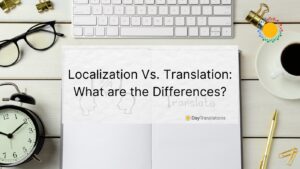If you’re looking to reach a global marketplace with multilingual content, website localization is the way to go. Localizing your website for a new market can be a daunting task. There are so many factors to consider, from choosing a language to localizing the interface, that it can be overwhelming. But it doesn’t have to be. In this article, we’ll discuss the do’s and don’ts of website localization.
We’ll cover everything from researching target markets and selecting languages to optimizing content and testing your localized website. With our tips and tricks, you can make website localization quick and easy so that you can take advantage of the global market without missing a beat!
Understanding Cultural Differentiation and How it Impacts Website Localization
Website localization begins with understanding the target market’s cultural norms. Understanding cultural nuances and adapting content to suit a local audience is important for gaining customers’ trust in the target country. Cultural differentiation requires an appreciation of subtle customs and other languages that may differ from your own.
For instance, certain words may have double meanings or evoke strong cultural reactions depending on the region. Sometimes, color can have a different connotation than what you originally intended in your native language. On top of this, certain topics may be considered taboo in a specific language. Therefore, researching differences between cultural practices is essential and should be done before launching any global campaigns or websites in foreign countries.
That said, there’s no single “right” way to communicate a message, so don’t be afraid to experiment with different communication styles and phrasing when appropriate. With research, testing and meaningful partnerships with local representatives, you can ensure that all of your messages are culturally relevant and impactful worldwide!
Analyzing Your Audience Before Rolling Out the Website Localization Process
Your website’s localization journey won’t be one size fits all—you need to be aware of your target audience in order to ensure your website is up to snuff for the culture for which it’s being localized. It’s not enough to simply translate the copy—you’ll also want to consider relevant customs, regional references, and other factors that may be more difficult to localize.
To make sure you’re creating a user experience tailored specifically for each location backed by a proper localization strategy, ask yourself these questions:
- Who is my target audience?
- What do they need?
- Are there any cultural elements or keywords I should consider including?
- Is the design and layout visually appealing in this region’s context?
Answering these questions can help you create content that appeals to the target audience, making them feel like they have something tangible they can connect with. Localization is all about giving global customers a seamless, enjoyable experience on your website no matter where they are in the world.
Localized Content Writing
Localizing content isn’t as easy as just translating text into a different language—there are many more elements to consider.
When writing content for a localized website, keep the following in mind:
Tone and Clear Writing
When writing for a global audience, it’s important to strike the right balance between professionalism and conversational language. Your content should be culturally appropriate, but also clear and concise so you captivate your potential customers. Keep in mind that some words may have different meanings in different cultures and across multiple languages, so choose your words carefully.
Cultural Relevance
Localized content must also be relevant to its intended audience—avoid making references that may not translate well or might not make sense outside of the original context. Research local slang and idioms, as these can make your writing sound much more natural.
Grammar and Punctuation
Grammar rules vary across languages and regions, so be sure to use native speakers who understand local conventions when proofreading your copy. Also, pay attention to punctuation—some cultures use punctuation marks differently than those used in English-speaking countries!
Test Your Site Before Launch
Testing your site before launch is a critical step in website localization if you want to ensure that the localized version of your website looks and functions just as the original. It’s about ensuring all content has been translated correctly and guaranteeing that all links and images are working properly.
To make sure your localized site works properly, it’s essential to perform a few checks:
- Review all texts on your website content, including meta descriptions and images, to ensure they’ve been translated accurately and convey the right meaning in their target language.
- Check all links, ensuring they lead to the right pages both internally and externally when clicked.
- Test all forms, such as email list opt-ins and contact forms, to ensure they display correctly in the local language and send emails without any issues.
- Make sure fonts are displaying properly in different languages. This includes languages whose characters don’t appear on typical keyboards, like Arabic or Chinese.
- Review any maps embedded on your webpage using language localization tools like Google Translate to ensure they appear correctly for visitors from different countries.
- Conduct user testing with native speakers from each language you’re targeting to get feedback about how well the experience translates for them.
By taking these steps, you’ll be able to make sure your site is optimized for users in different countries worldwide.
Adapt Your Website Localization Strategy for Each Target Market
Search engines like Google, Bing, and Yandex each have their own algorithms in place to determine a website’s relevance. That’s why it’s important to optimize your website with the appropriate language and keywords for each search engine.
When localizing your website, you should:
- Research the target languages you are translating into and ensure you are using the correct keywords that align with what people in that region search for.
- Make sure your content is properly optimized for each language by doing keyword research in those languages.
- Ensure all meta descriptions and titles reflect the actual content on the page to avoid any confusion or misrepresentation of your brand.
On the other hand, avoid:
- Filling pages with unrelated keywords just for SEO purposes – this can be ineffective or even penalized by search engines.
- Neglecting to research your target language’s culture and customs could lead to incorrect translations that could easily be avoided by researching correctly beforehand.
Ongoing Maintenance and Monitoring
In order to ensure that your website’s localization is successful, you must commit to ongoing maintenance and monitoring.
Maintenance
Once the content for your website has been localized, it is important to regularly check for any errors or outdated information in the foreign language version. This will help maintain the quality and accuracy of the content, keep it current, and ensure a positive user experience.
Monitoring
Monitoring your localized website should be an ongoing process, as well. You should pay attention to analytics related to traffic, search engine optimization (SEO) performance, and user engagement metrics such as time on page, bounce rate, and conversion rate. This will give you an insight into how users are responding to your localized content so that you can make changes if necessary. It will also provide valuable feedback for future localization projects.
Ready to Tackle Website Localization?
All in all, website localization must be approached strategically and strategically. When done correctly, localization can enable your business to reach out to new markets and expand your international presence, boosting brand visibility and providing new opportunities.
Localization is a process that requires careful consideration, attention to detail, and patience. It is important to select the right localization partner to ensure that the right resources, languages, and other factors are used to localize the website for maximum impact properly. Don’t forget to consider culture and content when localizing.
By following these website localization tips and tricks, you can effectively localize your website and reach out to the global marketplace with multilingual content. With the right localization partner, website localization can be made easy.














Sorry, the comment form is closed at this time.